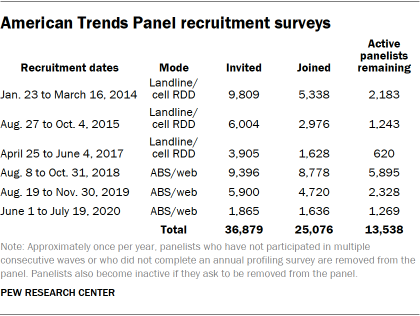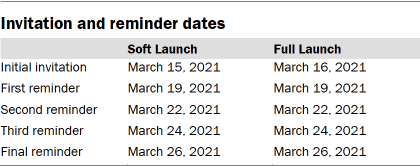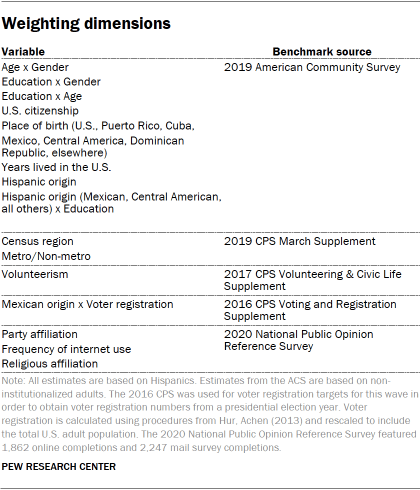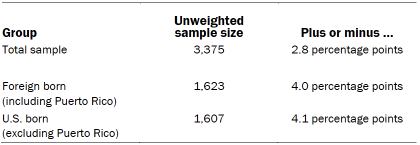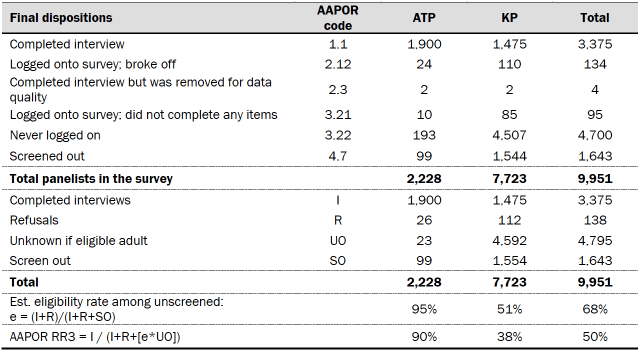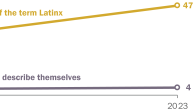The American Trends Panel survey methodology
Overview
The American Trends Panel (ATP), created by Pew Research Center, is a nationally representative panel of randomly selected U.S. adults. Panelists participate via self-administered web surveys. Panelists who do not have internet access at home are provided with a tablet and wireless internet connection. Interviews are conducted in both English and Spanish. The panel is being managed by Ipsos.
Data in this report is drawn from the panel wave conducted March 15 to March 28, 2021, among self-identified Hispanics from the ATP and Ipsos’ KnowledgePanel. A total of 3,375 panelists responded out of 9,951 who were sampled, for a response rate of 50% (AAPOR RR3). This includes 1,900 from the ATP and 1,475 respondents from the KnowledgePanel. This does not include four panelists who were removed from the data due to extremely high rates of refusal or straightlining. The cumulative response rate accounting for nonresponse to the recruitment surveys and attrition is 1%. The break-off rate among panelists who logged on to the survey and completed at least one item is 4%. The margin of sampling error for the full sample of 3,375 respondents is plus or minus 2.8 percentage points.
Panel recruitment
The ATP was created in 2014, with the first cohort of panelists invited to join the panel at the end of a large, national, landline and cellphone random-digit-dial survey that was conducted in both English and Spanish. Two additional recruitments were conducted using the same method in 2015 and 2017, respectively. Across these three surveys, a total of 19,718 adults were invited to join the ATP, of whom 9,942 (50%) agreed to participate.
In August 2018, the ATP switched from telephone to address-based recruitment. Invitations were sent to a random, address-based sample of households selected from the U.S. Postal Service’s Delivery Sequence File. Two additional recruitments were conducted using the same method in 2019 and 2020, respectively. Across these three address-based recruitments, a total of 17,161 adults were invited to join the ATP, of whom 15,134 (88%) agreed to join the panel and completed an initial profile survey. In each household, the adult with the next birthday was asked to go online to complete a survey, at the end of which they were invited to join the panel. Of the 25,076 individuals who have ever joined the ATP, 13,538 remained active panelists and continued to receive survey invitations at the time this survey was conducted.
The U.S. Postal Service’s Delivery Sequence File has been estimated to cover as much as 98% of the population, although some studies suggest that the coverage could be in the low 90% range.5 The American Trends Panel never uses breakout routers or chains that direct respondents to additional surveys.
About the Ipsos KnowledgePanel
The Ipsos KnowledgePanel is an online probability-based panel representative of the U.S. adult population. Households without internet connection are provided with a web-enabled device and free internet service. KnowledgePanel’s recruitment process was originally based on a national RDD sampling methodology. In 2009, the panel switched to using an ABS methodology. Additional information about the recruitment, sampling and weighting procedures for the Ipsos KnowledgePanel are available here.
Sample design
The overall target population for this survey was non-institutionalized self-identifying people of Hispanic origin ages 18 and older, living in the U.S., including Alaska and Hawaii. The ATP sample consisted of all current panel members that previously identified as being Hispanic. The KnowledgePanel sample included oversamples of Hispanics who were of Mexican or Central American ancestry or had no more than a high school education.
Questionnaire development and testing
The questionnaire was developed by Pew Research Center in consultation with Ipsos. The web program was rigorously tested on both PC and mobile devices by the Ipsos project management team and Pew Research Center researchers. The Ipsos project management team also populated test data which was analyzed in SPSS to ensure the logic and randomizations were working as intended before launching the survey.
Incentives
All respondents were offered a post-paid incentive for their participation. ATP respondents could choose to receive the post-paid incentive in the form of a check or a gift code to Amazon.com or could choose to decline the incentive. Incentive amounts ranged from $10 to $20 depending on whether the respondent belongs to a part of the population that is harder or easier to reach. Differential incentive amounts were designed to increase panel survey participation among groups that traditionally have low survey response propensities.
Ipsos operates an ongoing modest incentive program for KnowledgePanel to encourage participation and create member loyalty. The incentive program includes special raffles and sweepstakes with both cash rewards and other prizes to be won. Typically, panel members are assigned no more than one survey per week. On average, panel members complete two to three surveys per month with durations of 10 to 15 minutes per survey. An additional incentive is usually provided for longer surveys. For this survey, KnowledgePanel members were offered 10,000 points (equivalent to $10) in addition to the regular incentive program during the last few days of data collection to those who hadn’t responded yet in an attempt to boost the number of responses from panel members of Central American ancestry.
Data collection protocol
The data collection field period for this survey was March 15 to March 28, 2021. Postcard notifications were mailed to all ATP panelists with a known residential address on March 15, 2021.
On March 15 and March 16, invitations were sent out in two separate launches: Soft Launch and Full Launch. Sixty ATP panelists and 182 KnowledgePanel panelists were included in the soft launch, which began with an initial invitation sent on March 15, 2021. The ATP panelists chosen for the initial soft launch were known responders who had completed previous ATP surveys within one day of receiving their invitation. All remaining English- and Spanish-speaking panelists were included in the full launch and were sent an invitation on March 16, 2021.
All panelists with an email address received an email invitation and up to four email reminders if they did not respond to the survey. All ATP panelists that consented to SMS messages received an SMS invitation and up to four SMS reminders.
Data quality checks
To ensure high-quality data, the Center’s researchers performed data quality checks to identify any respondents showing clear patterns of satisficing. This includes checking for very high rates of leaving questions blank, as well as always selecting the first or last answer presented. As a result of this checking, two ATP and two KnowledgePanel respondents were removed from the survey dataset prior to weighting and analysis.
Weighting
The data was weighted in a multistep process that accounts for multiple stages of sampling and nonresponse that occur at different points in the survey process. First, each respondent begins with a base weight that reflects their probability of selection for their initial recruitment survey. For the KnowledgePanel respondents, the base weight also reflects their probability of being selected to participate in this survey. To combine the base weights for the ATP and KnowledgePanel, respondents were grouped into one of six cells depending on whether they had no more than a high school education and whether they were of Mexican, Central American or another Hispanic ancestry. The base weights for ATP and KnowledgePanel respondents were then standardized proportionately to their effective sample size within each cell and combined. This combined base weight was then poststratified so that the combined sample in each cell matched its share of the larger population of Hispanic adults.
In the final weighting step, the combined weights were calibrated to match the population benchmarks specified in the accompanying table and trimmed at 1st and 99th percentiles to reduce the loss in precision stemming from variance in the weights. Sampling errors and test of statistical significance take into account the effect of weighting.
The following table shows the unweighted sample sizes and the error attributable to sampling that would be expected at the 95% level of confidence for different groups in the survey.
Dispositions and response rates

